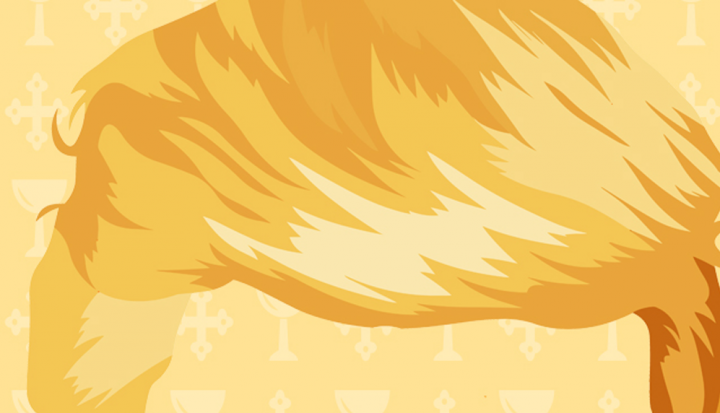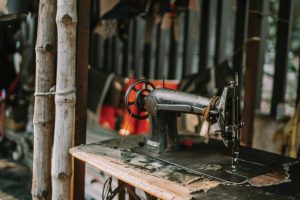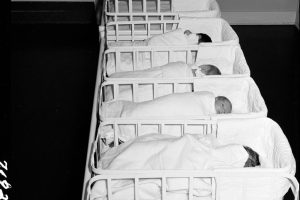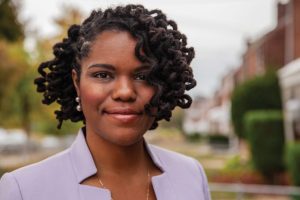Our feet crunch as we tramp through the woods, two Christians on an impossibly pristine New England autumn day. My host, Dominic Cassella, 23, leads the way beneath oaks and maples with orange and yellow leaves turned brown on the ground. We come upon an altar to the Virgin Mary surrounded by gray, crumbling bricks in a clearing in the woods.
An hour from the home of poet Robert Frost, in rural New Hampshire where the “nones” outnumber Catholics, we take a road less traveled into the heart of conservative Catholic America—a place where Thomas Aquinas is venerated, dormitories are off-limits to the opposite sex, and, in closets of historic homes converted to collegiate housing, MAGA hats hang on hooks next to shelves filled with Bibles, books of Aristotelian philosophy, and Confessions by St. Augustine.
I didn’t know yet if I was in Catholic heaven or Catholic hell. Or—as the daughter of a Lutheran mother and a lapsed Catholic father—if this was purgatory, where I’d hear the justification for an American Catholicism that had drifted far to the right and where I would be judged on my ability to understand it with grace while determining for myself its fidelity to the gospel.
We pause for a moment in front of the Blessed Virgin. I’m overcome, as I often am in Roman Catholic spaces, dwarfed by the history, mysticism, and power of ritual that my Protestant training could never subsume. Cassella is moved as well, and we quietly stand in the presence of Mary. Cassella has been kind this morning, gracious, patient, open to answering my inquisitive questions as part of research for a book I am writing about conservative Christian support for Donald Trump.
Trump’s Catholic support (he beat Hillary Clinton 60 to 37 among white Catholics) was among the most important and unexplained statistics of the 2016 election. Many dismissed Trump’s evangelical Christian support as predictable, a consequence of an American evangelical population often swayed by charisma or racism. Many commentators connected Southern evangelical Trump backing to evangelical support for segregation in the mid-20th-century American South.
Catholic support for Trump was unprecedented and complicated, despite the easy answer that it was about abortion. But the most extreme example of Trump’s conservative Catholic support was perhaps found here, in these tranquil New Hampshire woods—in the state where Trump won the primary en route to the Republican nomination.
A Catholic college to reclaim conservative Christian America
That autumn morning in 2018, long before whistleblowers and impeachment inquiries, I was visiting the home of conservative Catholicism’s most fervent believers. That morning I had driven from Concord, New Hampshire, where I’d interviewed a local parish priest, to a college that, the priest told me, considers itself the ideal collegiate destination for homeschooled Catholics who consider most parochial schools “not Catholic enough.”
Cassella doesn’t quite fit that description, though he’s close. He says he is the eldest of six and was homeschooled for just one year of high school before attending Holy Family Academy in the Washington, D.C. area. He points out that it’s not the fabled Catholic prep school that Supreme Court Justice Brett Kavanaugh attended, but Cassella did have friends from that school. Cassella says his dad is a Princeton-educated engineer who wasn’t keen at first on the idea of his eldest son attending a tiny liberal arts college in rural New Hampshire.
“But now that he’s seen the education, he wants all of his kids to go here,” Cassella says.
This college, which drew Cassella and the 29 others in his graduating class from states across America and even Brazil, the United Kingdom, and Canada, is unassuming, modest Thomas More College of Liberal Arts. I almost missed finding it, because I had to turn onto a dirt road with minimal signage to drive up to the campus, which consists entirely of a few stately, colonial-style houses repurposed as offices, a parlor, classrooms, a dining hall, and dormitories.
What Thomas More lacks in size it makes up for in influence and zeal. The college has just one major—liberal arts—but its goal is diametrically opposed to what most Americans would consider liberalism. At Thomas More young men and women aren’t allowed in one another’s dormitories. There’s no drinking, no organized sports, and no illicit drugs.
“We spend a lot of time having great conversation,” Cassella tells me. “The atmosphere here for dating is good.”
He doesn’t mention a particular dress code, but I notice all the women I meet on campus are dressed conservatively, wearing modest dresses or skirts. Students seem to come from affluent backgrounds, as evidenced by Cassella’s stylish glasses and expensive-looking leather blazer as well as his urbane manner of speaking. Yet the campus and its students’ and faculty’s scrubbed, self-consciously composed appearance make me wonder what lurks in the shadows.
Cassella insists that Thomas More’s aim is simply all about seeking truth and reading original Western texts. He mentions a required Rome program led by Maronite monks while offering me an espresso or an aromatic lemon ginger tea. I see a room for classes on woodworking and a basement classroom full of sculptures and art projects. I can sense the college’s admiration for a bygone age of education rooted in ancient Greece, where only the wealthy had the privilege of education for the sake of education.
At Thomas More, America and Catholicism—and by extension the world—are in trouble, and it’s only by a return to “liberal, Western” principles that the world might be saved. Cassella uses antiquated words like virtues, formation, and spiritual practices. He speaks of Protestant and agnostic students who have converted to Catholicism.
He tells me that it’s the Republican Party and conservatives who champion this “Western” tradition of free thought and free speech.
“Today if you want to be free-thinking and value thought, you are a conservative,” Cassella says, echoing arguments sometimes found in the pages of America’s most prestigious conservative publications. “You saw during the Kavanaugh trial that the left wing does not allow for free thought or freedom of the individual.”
As Cassella shows me student depictions of Michelangelo’s David, I am struck by how utopic this world seems, removed from the barriers of sexism, classism, racism, and homophobia that so often scar and divide American contemporary life. Maybe I wouldn’t have minded dwelling in this world a bit longer, and I probably would have been welcomed, since I am white, Christian, and heterosexual.
Cassella speaks of politics as an intellectual exercise, removed from the barbaric shouting and partisan posturing seen on cable news. When I ask about support for Trump, the bombastic and boisterous type of character who might seem out of place at this intellectual Catholic island, Cassella takes a sip of his tea and pauses.
“Originally it kind of cut a little deep,” Cassella says. “He is basically the face of the nation and there was such a lack of trust [in the 2016 election].”
Then Cassella’s face brightens. He has an opportunity for an intellectual exercise beloved by the Greek philosophers he’s been studying at Thomas More.
“The question was, can you morally support someone who is not a moral person?” he says.
Initially, Cassella says, Thomas More students were divided on this question. But he tells me about a Trump rally that took place in nearby Manchester as Trump romped through the early Republican primary campaigns.
Although Trump’s crowds are often depicted by mainstream media as undereducated, rural, blue-collar, rough-around-the-edges type folks, Cassella says Thomas More students, with their polished exterior and traditional commitment to intellectualism, fit right in.
“We all went,” Cassella says of the rally. “You saw a lot of MAGA hats on campus.”
As he tells me more about what troubles him in the 21st-century American Catholic Church, I learn that Cassella’s and his counterparts’ support for Trump is less about Trump’s personal appeal and more about a long-running belief among many conservative Catholics that the country is moving in a dangerous direction, and so is the Catholic Church.
As I would hear later from many more conservative Catholics, Pope Francis has only increased their worry with his ambiguous statements about gay and lesbian people in the church and the potential for married priests. Francis is already an object of suspicion for many conservatives, who for decades trusted in European and conservative preeminence in the church. Now a pope from the Southern Hemisphere, tainted by liberation theology, challenges the direction of the church in total, causing alarm in an American church rocked by the clergy sexual abuse crisis and ever more aware of its shrinking numbers of adherents and worshippers.
Cassella, like many American conservative Catholics, believes that the clergy sexual abuse crisis is partially attributable to a large number of gay priests entering the priesthood in the 1960s and ’70s, even though homosexual identity is not linked to sexual abuse.
Cassella goes further than most American Catholics, however, when he says that even a celibate gay man could not serve in the priesthood.
“You’d want a naturally ordered man,” Cassella says, visibly uncomfortable. “[Gay men] might need help. They should not be in the position of helping others.”
It’s one of the first times in our conversation that I hear Cassella say something that is discriminatory on its face. His antiquated language of “naturally ordered” reminds me of the ways such language has been used to dehumanize people across the world for thousands of years. Perhaps even Jesus himself was persecuted partly because he was the child of unmarried parents, the son of a carpenter, a Galilean, and a disobedient Jew who performed miracles on the Sabbath.
Steven P. Millies, author of a book about Catholic voters from Roe to Trump and an associate professor of public theology at the Catholic Theological Union in Chicago, says that benign phrases like liberal arts and Western education have become code words among some conservative Catholics.
“I really believe in liberal arts education, and I really believe in the humanities,” Millies says. “I really believe that the Christian and Western contribution to world culture is important. But I have to say that those are code words for a lot of people.”
“We must always be outward looking and there is always something new to learn,” Millies continues. “There’s a wide universe of things out there to absorb. A wide range of tools. But something wonderful—when it’s turned inward on itself, like the embrace of liberal arts and Western thought alone—becomes not very Western and not very healthy.”
Thomas More, with its tiny enrollment and small footprint, may have an outsized influence on conservative Catholicism due to the zeal of its students and their global connections. They have an incredible sense of mission that most American religious leaders would love to see in their parishioners. The college represents a small extreme of a growing edge of conservative Catholicism, a connection to right-wing, sometimes aristocratic, European movements and a privileging of elite white men. Thomas More proves that conservative Catholicism is not only for Baby Boomers and older. There is also a rapt audience for extreme conservative ideas within the whole American Catholic Church, including its youth.
Still, Thomas More is but a tiny outlier of a broader national picture of red-state Catholics and their vote for Trump. Perhaps a more nuanced view of these voters comes up the road from Thomas More, in Concord, where I met Kathleen Hedstrom, leader of the local Sanctity of Life group.
Pro-life priorities
Hedstrom, 74, is the middle of seven children raised in a proud Catholic family in Milwaukee. She became a nurse and moved to Oakland, California during the heyday of the ’70s psychedelic and free-love culture. She saw young men come back from the Vietnam War with missing limbs and watched young women with vacant eyes get lost in the world of psychedelic drugs. Soon it was too much. Hedstrom moved to New Hampshire, where she’d always dreamed of seeing fall foliage. After the death of her first husband, whom she’d divorced years earlier, she married again in the Catholic Church. When I met her she’d been widowed again and had thrown herself into advocacy for her local Sanctity of Life group.
Hedstrom is committed to advocating against abortion and capital punishment in New Hampshire. She speaks of a moving march in nearby Manchester, carrying the Blessed Sacrament through the streets from a Planned Parenthood and back. Like many zealous for religious causes, Hedstrom has a personal story. She talks about being 40 years old and pregnant with her fifth child, Michael. Her doctor told her the baby had an abnormality in its skull and suggested an abortion. When she got a second opinion, she learned the first doctor had been mistaken. Her baby was born healthy.
That experience for Hedstrom had a mystical truth within it. She became passionately active against abortion, traveling by bus to the March for Life in Washington, D.C. and following the ministry of Father Frank Pavone, a controversial priest who leads the National Pro-Life Religious Council and has been under investigation by the Archdiocese of New York for financial practices in his organization, Priests for Life. The night before Trump’s election Pavone, a member of Trump’s Catholic advisory council, presented a video of himself preaching next to what he said was an unclothed aborted baby.
Despite Pavone’s dubious reputation within the church, he remains a major influence to conservative Catholics like Hedstrom, who says her decision to vote for Trump was due to Pavone’s urging to look at Trump’s platform in comparison to that of Democrats.
Like many of the conservative Catholics I talked to across America, Hedstrom acknowledges her differences from Trump and Republicans about immigration law, saying she’s worked with refugees and understands their predicament. But like many conservative Catholics I talked to, Hedstrom quickly pivots from immigration back to abortion when talking about her political views.
“[Immigration] is a complex issue,” she says. “It was just too hard, so I focused on abortion.”
I notice echoes of Cassella’s criticism of Pope Francis in Hedstrom as well.
“I think Pope Francis is a holy man, but he comes from . . . you might say a socialist country, and socialism has no place in the church,” she says.
Two major issues, conservative economic policy and pro-life activism, surface again and again in conservative Catholics’ decision to support Trump.
A young parish priest, charismatic renewal, and politics in the pulpit
Thousands of miles from Hedstrom and Cassella, in an affluent corner of liberal south Minneapolis, I meet with a conservative-leaning 38-year-old parish priest, shaped by his youth spent with evangelicals in Fort Worth. He grew up in a parish marked by charismatic renewal and joined an evangelical fraternity at Texas A&M University.
I have known Father Brian Park for nearly 10 years, since he was a Catholic seminarian serving with me as a chaplain intern at the Minneapolis Veterans Hospital.
I was interested in Park’s take on 21st-century American politics and Trump and knew that Park had been shaped by many facets of Trump’s electorate. Park, who voted for a third-party candidate in 2016, grew up in the heart of the Bible Belt. He is the son of a Catholic convert father and devout mother, had his own conversion experience at age 18, and was shaped irrevocably by evangelicalism.
One of the few Catholics at his local public school, he had always attended Mass with his family but saw it more as a matter of tradition than personal faith until 1999. That year, returning home from his first year of college, Park attended Mass following a mass shooting at Wedgwood Baptist Church in Fort Worth in which seven people were killed during a prayer rally. Park says he found himself crying for the final 30 minutes of that Mass, overcome with emotion and the powerful presence of God.
“I heard, ‘I love you. Come follow me. Do not be afraid,’ ” Park recounts the words today, their power still evident in his remembrance.
Park returned to A&M determined to follow God’s words, though at the time he was not powerfully called to the priesthood. Instead he joined an evangelical fraternity called Brothers Under Christ. Of the roughly 250 men in the fraternity, he says, just two of them were Catholic. The rest attended a couple of big Southern Baptist and nondenominational megachurches in College Station, emblematic of the evangelical conservative Christianity that would prove influential in Texas and Republican politics for years to come.
Park briefly considered joining one of those non-denominational churches and leaving the Catholic Church. But then he started voraciously reading theology and became convinced that the Catholic Church’s long history and trajectory were the only way forward. Park heard about a Minnesota-based group called NET (National Evangelization Teams) Ministries from one of the Catholic priests serving at A&M’s Catholic campus ministry.
He spent a year leading retreats with NET Ministries and then served on staff for three years, becoming more and more called into the priesthood. During this time Park also connected with the Companions of Christ, a group of local parish priests in the Twin Cities committed to living together as brothers in ministry. This promise of brotherhood while forgoing the lonely life of a parish priest living alone in a rectory convinced Park to apply for seminary within the Archdiocese of Saint Paul and Minneapolis. Since 2015 he has served as pastor of the Church of the Annunciation in south Minneapolis, following two years at St. Charles Borromeo. He still serves with NET Ministries as a chaplain.
Park made local news in Minneapolis after being criticized for intervening in an Annunciation teacher’s decision to air a humanitarian video in which a woman talked of leaving her husband to be with another woman. The teacher who aired the video was reprimanded by Park and ultimately resigned before the end of the school year, telling local reporters that she’d been treated unfairly. Some former Annunciation school parents wrote to the local newspaper, suggesting that Park was forcing a conservative influence at the school.
The uproar over Park’s intervention in Minneapolis is a reminder that all politics are local. While Park is likely more conservative than many of his neighbors in south Minneapolis, the home district of U.S. Representative Ilhan Omar (D-Minn.), he says he’s generally moderate.
“I try to avoid the extremes,” he says. “Except in love. I always want to love in an extreme way.”
Compared to the rhetoric I heard at Thomas More, Park’s conservatism seems relatively moderate, regardless of how he handled the situation with the teacher and the video.
Beyond my personal friendship with Park, what endears him to me is something I saw in most of the conservative Catholics I interviewed to tell stories of red-state Catholic Trump voters. Most of them genuinely believe that America needs a return to more religious roots, that returning to more conservative ideals in things like marriage, birth control, and abortion would lead to a more loving, more Christian country.
Where they get off-base is when their ideals and visions collide with actual people. I wonder if Cassella would still say gay men are not “naturally ordered” if one of his close friends or family members came out to him as gay. I notice Hedstrom wants to advocate for pro-life ideas in a consistent way and speaks passionately about her activism against the death penalty. Hedstrom only becomes angry or agitated when she is quoting Pavone or mentioning something she’s seen on TV, like the Kavanaugh trial and the way Saturday Night Live makes fun of conservatives.
As for Park, I notice him soften when he talks about his parishioners, the ones who came to him after a divorce asking if they’d ever be accepted at Mass, the ones who told stories of being abused by a priest, even the ones who criticized him and, in his perspective, mistook his conservative views for hatred or as something that would damage their parish.
I can tell he really cares what they think, just as I can sense his discomfort and disapproval of Trump’s rhetoric about the environment and immigration.
In these pauses, in these displays of openness or vulnerability among red-state Catholics, I sense hope for America’s Catholics. The “big tent” of Catholicism has always had an ability to hold within it a diverse worldwide constituency of believers: Jesuits, Benedictines, religious sisters, union members, parish instructors, Irish, Italians, Mexicans, Americans.
“One of the reasons I think the church has been able to have that big tent is simply because of scale—overwhelming size—at least in the United States,” Millies says. “What we know is that we have lived for the last 30 to 40 years, particularly 10 to 20, to see dramatic shrinking in the number of people who are showing up for Mass. Catholics see the walls closing in, and they start wondering, ‘Who should be in here?’ ”
American Catholic conservatives and liberals might have different answers to who should be in the White House, but hopefully as the 2020 election approaches they can agree that Catholics of all political persuasions need one another, especially at Mass.
This article also appears in the February 2020 issue of U.S. Catholic (Vol. 85, No. 2, pages 12–19). Click here to subscribe to the magazine.















Add comment